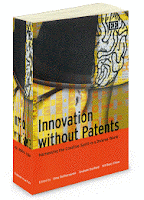China signs up for copyright treaties; Innovation without patents
 On 9 June 2007 - well ahead of the Olympic Games in Beijing in 2008 - the People's Republic of China gives effect to the WIPO Copyright Treaty 1996 and the WIPO Performances and Phonograms Treaty 1996 (see press releases here and here).
On 9 June 2007 - well ahead of the Olympic Games in Beijing in 2008 - the People's Republic of China gives effect to the WIPO Copyright Treaty 1996 and the WIPO Performances and Phonograms Treaty 1996 (see press releases here and here).Right: Chinese authorities road-testing their latest anti-piracy steam-roller
Two caveats, though:
* the accessions don't currently apply to Hong Kong or Macao;The IPKat wonders whether any of his readers, from China or elsewhere, would like to explain what the problem is with Article 15(1), or with its acceptability.
* China does not consider itself bound by Article 15(1) of the WPPT, which states that "Performers and producers of phonograms shall enjoy the right to a single equitable remuneration for the direct or indirect use of phonograms published for commercial purposes for broadcasting or for any communication to the public".
 Innovation without Patents is the title of a new book, edited by the triumvirate of talented academics Uma Suthersanen, Graham Dutfield and Kit Boey Chow, which has just been published by Edward Elgar (details online here). This book, the blurb says, is concerned with the extent to which innovations should or should not be protected as intellectual property, and the implications this has upon the ability of local manufacturers to learn to innovate. It comes with an endorsement from the IPKat's friend and distinguished scholar Thomas Dreier (University of Karlsruhe, Germany):
Innovation without Patents is the title of a new book, edited by the triumvirate of talented academics Uma Suthersanen, Graham Dutfield and Kit Boey Chow, which has just been published by Edward Elgar (details online here). This book, the blurb says, is concerned with the extent to which innovations should or should not be protected as intellectual property, and the implications this has upon the ability of local manufacturers to learn to innovate. It comes with an endorsement from the IPKat's friend and distinguished scholar Thomas Dreier (University of Karlsruhe, Germany):"Focusing on innovation and development, this book, easy to read and full of interesting detail, provides both valuable insight into the theoretical framework of innovation as supported by intellectual property protection and contains valuable case studies of national systems of innovation in the Pacific Rim States".What the IPKat says: this book's title alone suggests that is a companion volume to Death of Patents (see details and IPKat comments here), but it is quite a different proposition. Nine of the book's eleven are authored or co-authored by the editors, which means that there is a far greater sense of intellectual integration between the chapters than one normally finds in a collection of critical essays on any aspect of IP.
The book's subtitle is an eloquent mission statement: "Harnessing the Creative Spirit in a Diverse World" - not only creative spirit but techniques of legal protection are there to be harnessed in a world of contrasts. The old industrial nations are now creeping back, like snails into their shells, into the security of the known as they seek to shrink into the shadow of their environmental footprints. The developing world, no longer slaves or serfs but the new entrepreneurs and innovation hothouses of the planet, surge forward meanwhile, embracing change with a rapidity that is almost beyond the individual's comprehension.
The current patent system is both facilitator and stumbling block, as the editors recognise, and the problems raised by 'borderline' inventions at the margins of patentability, as well as the detection and deterrence of free-riders, reflect this ambiguity. The editors are to be congratulated on putting together such a good and enjoyable read, complete with a set of conclusions and recommendations.
What Merpel says: did I hear someone say this book was endorsed by a hair dryer ... ?
Bibliographic details: x and 206pp. Hardback, ISBN 978 1 84542 959 1 . Price £59.95 (with online discount from the publisher, £53.96). Also available as an ebook 978 1 84720 444 8. Rupture factor: no problem.
